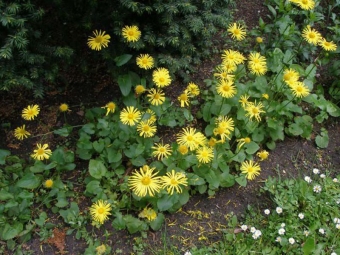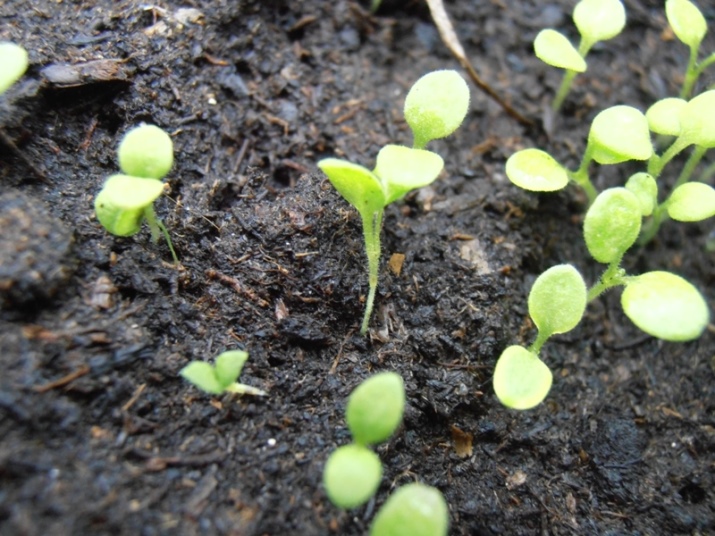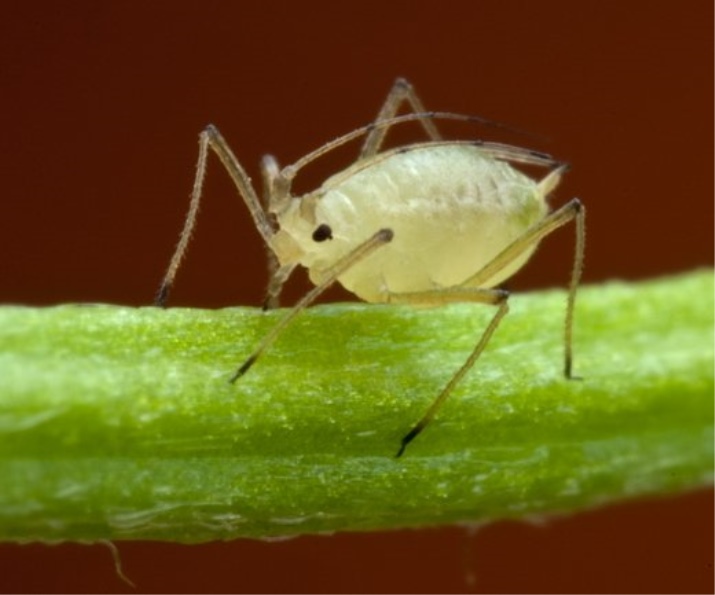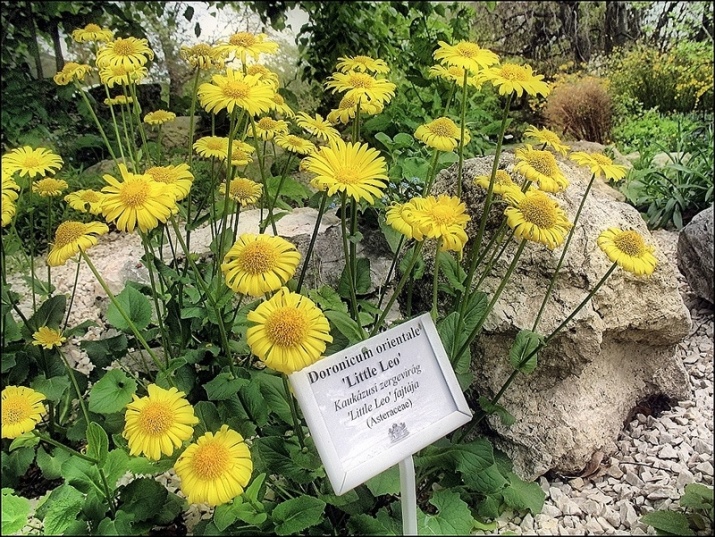Doronicum - yellow "chamomile"

Doronicum - yellow "chamomile" or kazulnik, perennial spring plant of the genus flowering.It belongs to the Astrovykh family, the class of dicotyledons. Perennial has about 36 species and is very popular among lovers of ornamental plants. In the people he is known as "solar chamomile."
Description
The name Doronicum is derived from the Arabic "doronish" - "unknown poisonous plant." In most species, the upper (ground) part of the flower is poisonous, but this is not an obstacle to the breeding of a beautiful and unpretentious plant in the care.
Externally, a doronicum is a perennial plant with a few branchy, almost straight stems. Its homeland is the mountainous and foothill areas of the temperate zone of Eurasia. Depending on the species, doronicum may be of different heights.
The leaves of the "yellow" chamomile have a pleasant color of spring greenery and a different shape:
- the lower ones (located at the fibrous root) are petioled, resembling an elongated oval;
- stem (encompassing the stem, not having a stem) - resemble an oval with a sharp edge or an elongated narrow heart.
The arrangement of the leaves is alternate. Those that make up the rosette have long petioles. Each sheet is characterized by a barely noticeable pubescence. The bare stem leaves at the edges are covered with a glandular formation.
Flowers with yellow petals and a bright middle are like a daisy-colored daisy. Inflorescence itself is a basket of yellow color with reed and tubular petals. Petals in the form of reeds are located in one or, more often, two or three rows, they have an elongated oval shape (sometimes sharp ends). The tubular ones form a lush center, which due to the shape in the form of rolled tubes looks darker against the petals.
The fruit of the plant - seeds brownish or brown in size 2-3 mm. They appear as a result of pollination of a flower and have germination for two years.
In most varieties, the flower resembling a chamomile is solitary and is located on a flower stalk without leaves. Some species differ in the presence of from two to six flowers in shitkovye inflorescences.
Types and varieties
In our country, gardeners liked several plant species:
Doronicum Oriental or Caucasian different shade tolerance, continuous ground cover, medium height and lush flowering of single flowers. The plant is known as ornamental and is often used to decorate the background. The species is considered early flowering and medium-flowered: the diameter of the flower does not exceed 6 cm.
The most popular varieties of gardeners are:
- Golden Dwarf (dwarf variety);
- "Little Lion" (handsome 30 - 35 cm);
- Orientale (ephemeroid up to 50 cm);
- Spring Beauty (terry camomile 40 - 45 cm).
For undersized varieties applies Clusazwhich growth can be 10 cm and rarely exceeds the mark of 30 cm. Depending on the time of planting and the region, this handsome man can afford to bloom from beginning to end of summer.
Among other varieties distinguish:
- Doronicum Columna - compact low plant (up to 40 cm). The most prominent representative of this species is the varietyGolden Ostrich», Which is characterized by a branched stem and an elongated tuber-like rhizome. The petals of the inflorescence are also different: in Kolumna they are narrow and somewhat pointed.
- Austrian yellow daisy slightly higher - its height is about 70 cm in height. Flowers are collected in inflorescences and in spring they are pleased with lush flowering.
- Doronicum plantain (Austrian) is recognized as a giant of its kind. The average growth of varieties is 1 m and often reaches 1 m 40 cm, its flowers are rather large: 11 - 12 cm.
This species is remarkable in that it has almost straight stems and leaves with pubescence. It blooms later oriental varieties for about one week. In nature, perennial perennial spread in the southwestern part of Europe. Popular varieties of this species are recognized Miss mason and Harpuf crewe.
Dimensions
Such indicators of flowering perennial depend on the type and variety. In addition, they are affected and care for the plant, as well as the composition of the soil. Therefore, the same variety can be luxurious and large in one region and low in another.
The average height of the bush varies from 30 cm to 1 meter. Dwarf ornamental varieties grow in height not more than 10 - 15 cm, others (plantain) surprise not only with a height higher than 130 - 140 cm, but also with large inflorescences (more than 12 cm). Interesting and colorful flowers for the landscape are perennials of medium height (30 - 35 cm). Unlike small flowers, they can decorate not only the foreground.
Noteworthy are the sizes of flowers. Even in small and short flower beds, they can be large. On average, the diameter of flowers varies from 5 to 12 cm.
Flowering period
The shrub is considered a spring plant, it decorates a garden in the spring when the first foliage begins to appear. In regions where winter is not so cold and springtime heat comes earlier, the first flowers may appear in early May.
The main period of flowering is the time from mid-May to the end of June. In some cases, gardeners have the opportunity to admire the beauty of "solar chamomile" in July. Sometimes the plant after rest gains strength and pleases with lush buds, even in August.
The flowering period depends not only on the region, the plant variety is important. For example, the main flowering period of Austrian doronicum falls on July, eastern - in the middle of May and the end of June. The flowering period averages from 30 to 40 days.
Breeding
Like all plants of the Astrov family, doronicum multiplies by seed. Outwardly, they look like small parachutes that fly away with a gust of wind, contributing to spontaneous seeding of culture. Seeds are usually harvested after the parachutes turn brown and take on white “caps”. The seeds themselves are very light: in one gram of them there can be up to 6 thousand pieces.
In addition to the seed method, the shrub can be propagated by dividing the bush or segments of rhizomes.
If during the summer doronicum has grown strongly, it must be rejuvenated by the method of division. Sometimes it seems that this procedure is optional and sufficient seeds. However, the division eliminates the aging of the perennial, which is accompanied by the death of old stems, a decrease in the size of the flower and the deterioration of its shape.
A bush that has not been divided for more than three or four years looks untidy and gives out its old age. If you want doronicum to enjoy this beauty, not degenerate, the flowers remained large, and the growth corresponded to its appearance, you will have to rejuvenate its division every year.
Growing: planting and care
Planting a flower from seeds can be done in two ways:
- In the form of seedlings. This method is more reliable, although it takes more time. The usual sowing time is April. In order for the saplings to survive the spring frosts, they are waiting for their landing on a permanent place in room conditions. This allows you to get more seedlings and save seedlings from death in the open air.
- Seedless method. This method is suitable if the seedling time is missed. Seeds are planted directly in the ground in May or towards the winter (in late October - early November).
Each method deserves attention and has features, so gardeners themselves choose how it is more convenient to plant a flowering perennial. You can not select only one of them, since they are both correct.
At home
To ensure greater germination, future seedlings provide the most comfortable conditions:
- the tray in the form of cells is filled with a mixture of sand and peat in a 1: 1 ratio;
- 2 - 3 seeds are sown in a cell (to a depth of 0.7 cm);
- tray covered with glass or transparent film and put on the windowsill;
- so that the soil does not lose moisture, it is irrigated with a spray;
- with the advent of germs, the film or glass is removed;
- when the seedling reaches a height of 4–5 cm, 1 strong is left in each cell, carefully pinching off the weak ones near the soil itself;
- in the phase of the third leaf, the top of the seedling is plucked off: this way the bush will be lush.
At the time of planting, strong seedlings are taken out of the cells along with the ground directly into prepared holes, the distance between which should not be less than 30 - 40 cm. After this, the seedlings need to be buried and watered. So that they are less painfully experienced through the adaptation process, they are watered more often (every day) at the initial pores, then the irrigation regime is reduced and reduced to moderate.
In the open ground
In some cases, gardeners do not have enough time to plant. Then proceed as follows:
- first, find a semi-dark spot, ideal for the seedlings not to burn under the scorching rays of the sun (it is desirable that the soil be slightly acidic);
- the selected site for sowing is being dug up, not forgetting to make a special complex fertilizer for flowering plants;
- in the prepared and dug soil make shallow grooves (sowing depth is 0.5 - 0.7 cm), irrigate them with water and sow the seeds.
If the plants are planted before winter, it is worth considering that watering the soil will cause rotting or freezing of seeds. It is not just not necessary: it is unacceptable.
Care
Since doronicum is not a capricious plant, it is not burdensome to care for it:
- It loves light, but is able to put up with penumbra. Watering should be regular and moderate: you can not fill the roots with water so that the moisture stagnated. Doronicum more easily tolerates short-term drought than excess water. To simplify the mode of irrigation and make it infrequent, the soil around the bush is better to overlay with wood chips. If not, then cut grass will do.
- Doronikum loves mineral supplements and organic fertilizers. However, it is necessary to please them with a bush in very small portions at the very beginning of the vegetative period and just before the perennial blooms.
- "Solar daisy" is afraid of digging and loosening the soil. This can affect the rhizomes, which are located close to the soil surface. Injury to a plant can cause its illness.
If the care in terms of watering and moisture conservation is sufficient, it will prolong the perennial flowering time by one and a half weeks.
- Once the doronicum has faded, the shrub is pruned. The dried-up look of flowers and leaves will spoil the picture of a blooming garden, and the plant itself after rest in need of rest. If the care is correct and regular, the rested doronicum can once again season the gardener to please the gardener with lush flowering.
- Any special preparation of a bush for winter is not required. This plant is frost-resistant and quietly tolerates even very low temperatures. The only way to help a shrub survive a harsh and snow-free winter is simply to sprinkle it with dry foliage or spruce leaves.
See the next video for details on growing and caring for doronicum.
How to save from diseases and pests?
Like any other plant, doronicum can suffer from thrips, leaf and gall nematodes, and the omnipresent aphid, which feeds on the sap of stem cells at the base of the plant. It can not only cause serious harm to perennials, but also completely destroy it.
If suddenly on the plant found characteristic strips or specks of yellowish color, the flowers began to fall off and lose their attractiveness, an urgent need to get rid of pests. In this case, insecticides will help to save doronicum (“Malathion», «Acarin», «Fufanon», «Atkara"). When plants are damaged by nematodes, they are dug up and burned.
Slugs are considered to be no less a problem of bush disease: they destroy greens. It will be more difficult to get rid of them, since it is necessary to collect each individual manually.After all pests have been removed, it is necessary to sprinkle the surface of the soil around the bush with mustard powder or ground pepper.
Diseases of the plant speak eloquently about the wrong care. If doronicum is affected by a fungal disease, treatment methods are as follows:
- when gray rot is detected from a bush, all that is infected is removed to save healthy shoots;
- only fungicides (Oxyh, Fundazol) will help to cope with rust and powdery mildew.
In addition, you can not create conditions in which the perennial will lose resistance to disease. It is worth considering that in the rush to achieve large inflorescences you should not be zealous with fertilizer, generously moistening and supplying the soil with manure. Flowers can really be beautiful and large, but the shrub itself will be pampered and susceptible to any infection.
Application in landscape design
Landscape designers recommend using flowers in the background of complex flower gardens. Against the background of a group composition of high and short flowers, doronicum will adorn any garden, adding solar paints to it. Dominating spring, he will give way to summer flowers, allowing them to change the style of the landscape.
For him, bulbous flowers and plants with decorative broad leaves are considered excellent neighbors. Since at the end of flowering perennial loses its attractiveness, such "neighbors" will cover an untidy place, without disturbing the landscape composition. A good neighborhood of the multi-tiered composition will be a combination with red tulips, orange roses, fern, nivyanik, rogersiya, nomadic, pyrethrium.
This shrub looks very beautiful not only among flowers: it is harmonious in composition with a decorative stone and small statuettes. In addition to group plantings, "sunny daisy" looks good alone, creating bright yellow spots against the background of the first spring greens.







































